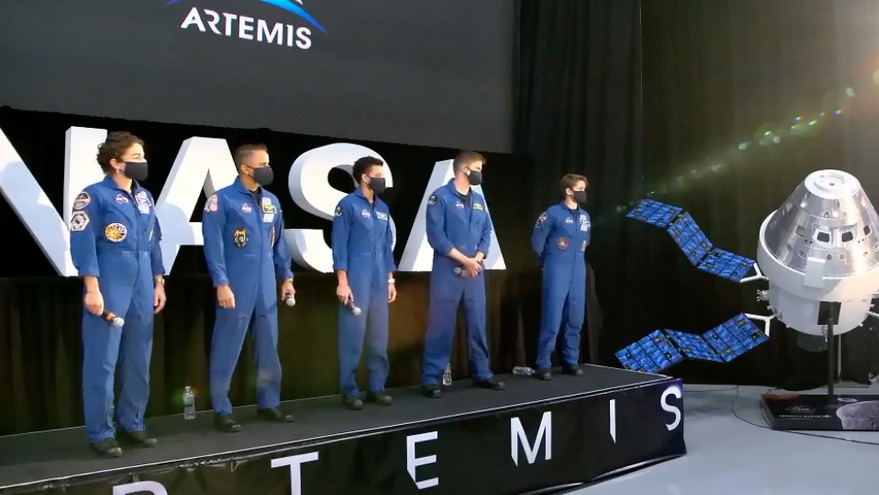WASHINGTON — NASA has selected a team of astronauts who will be eligible for future Artemis missions to the moon even as the prospects of a 2024 crewed landing continue to dim.
NASA Administrator Jim Bridenstine announced at the Dec. 9 meeting of the National Space Council at the Kennedy Space Center that the agency selected 18 members of its current astronaut corps for a new “Artemis Team.” Those astronauts will be eligible to be assigned for future Artemis missions, starting with the Artemis 2 flight of the Orion spacecraft around the moon.
“My fellow Americans, I give you the heroes of the future who will carry us back to the moon and beyond, the Artemis generation,” Vice President Mike Pence, chair of the council, said after reading off the names of the 18 astronauts. Five of the 18 were present at the meeting.
The 18 astronauts — nine women and nine men — are a diverse subset of the overall NASA astronaut corps. Some have flown multiple missions and spent almost a year in space, while others are rookies yet to make their first spaceflight. Two of them, Vic Glover and Kate Rubins, are currently on the International Space Station.
NASA did not disclose why it selected those astronauts, or the criteria the agency used, but noted in a release that additional astronauts, including those from international partners, will be added “as needed” in the future. “This is our first cadre of our Artemis astronauts,” Bridenstine said. “I want to be clear: there’s going to be more.”
“There is so much exciting work ahead of us as we return to the moon, and it will take the entire astronaut corps to make that happen,” Pat Forrester, chief of the astronaut office, said in a statement.
NASA has yet to assign crews to any Artemis missions. At a Dec. 7 media briefing to discuss a report on the science that could be done on Artemis 3, Ken Bowersox, deputy associate administrator of NASA’s Human Exploration and Operations Mission Directorate, said the “flight specific” training for that first landing mission would start a year and a half to two years before the mission. “So, we still have a little bit of time before we get there.”
NASA may have more than a little bit of time. Artemis 3 is notionally planned for 2024 in order to meet a goal set by Pence at a March 2019 National Space Council meeting, when he called for humans to return to the moon within five years. NASA’s Artemis activities have, since that speech, been shaped by that goal.
However, it is increasingly unlikely Artemis 3 will land humans on the moon in 2024. The incoming Biden administration, while supporting the broader effort to return humans to the moon, has not endorsed the 2024 deadline, suggesting it may slow down the program. Moreover, House and Senate spending bills for fiscal year 2021 provide only about $600 million and $1 billion, respectively, for the Human Landing System (HLS) program to develop lunar landers, far less than the $3.3 billion requested by NASA.
“The budget request gave us what we needed to achieve a 2024 moon landing, and as of right now, this agency is meeting all of its milestones,” Bridenstine said at the council meeting. He thanked the House and Senate for providing at least some funding for HLS, but acknowledged those bills are less than what NASA needs to keep a 2024 landing on schedule.
“Ultimately, if we don’t get the $3.3 billion, it gets more and more difficult,” he said.
Much of the nearly two-hour National Space Council meeting was retrospective, looking back at the accomplishments of the last four years as the Trump administration winds down. The council used the meeting to release an updated version of the National Space Policy, which does call for a human return to the moon by 2024.
There was little other discussion at the meeting of the 2024 goal, though. Pence noted in his opening remarks that this was the 48th anniversary of Apollo 17, the last Apollo lunar landing mission, with mission commander Gene Cernan the last person to walk on the moon. “We are going to honor Gene Cernan’s memory by putting the next man and the first woman on the moon in just a few short years,” he said, without explicitly mentioning 2024.
The astronauts who are part of the Artemis Team, such as Anne McClain, did not seem concerned about when they might go on the moon during a media availability after the council meeting. “Either I’m going to walk on the moon or one of my friends is going to walk on the moon, and both of those scenarios are beyond my wildest dreams when I was a kid,” she said.
